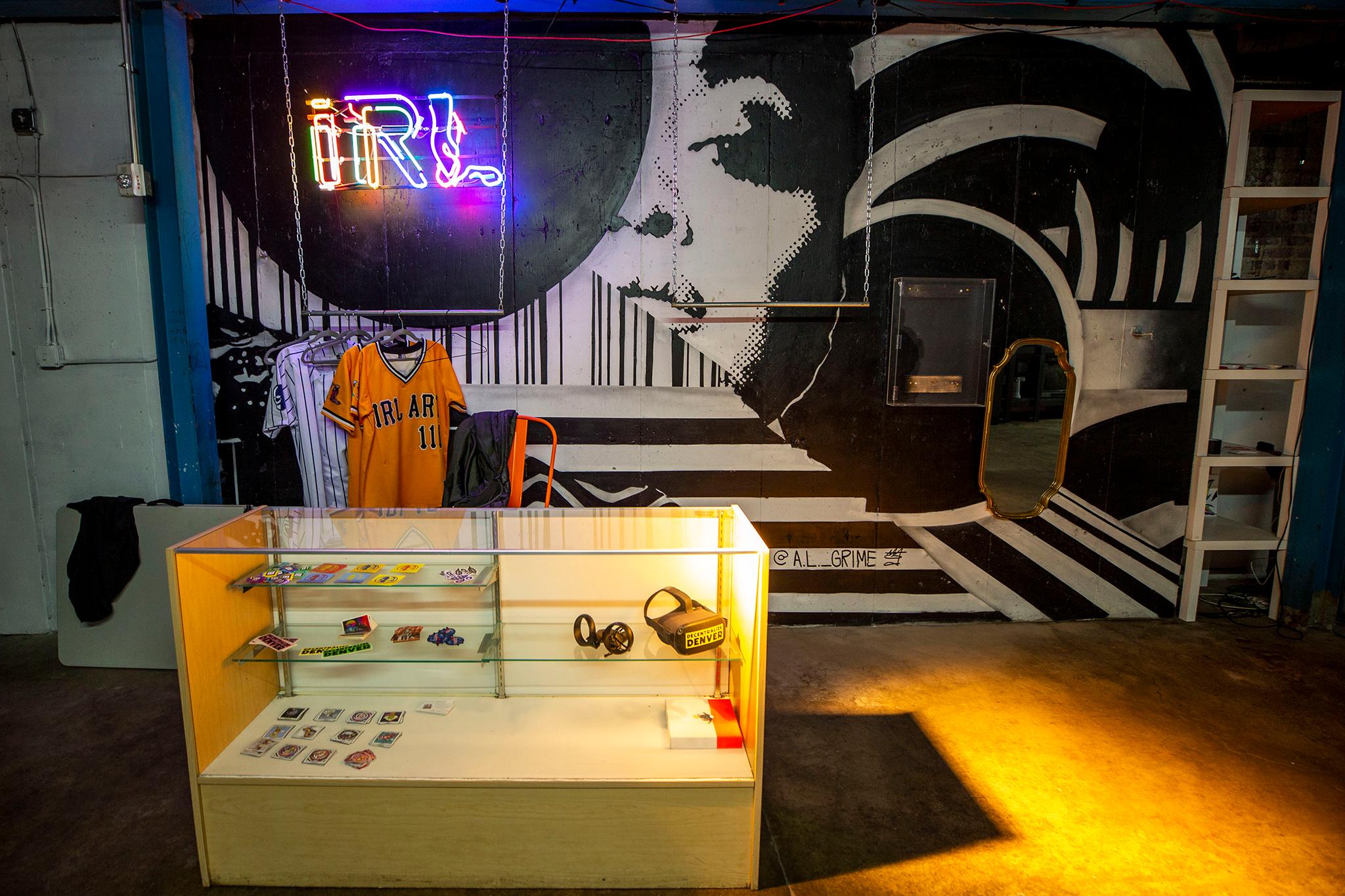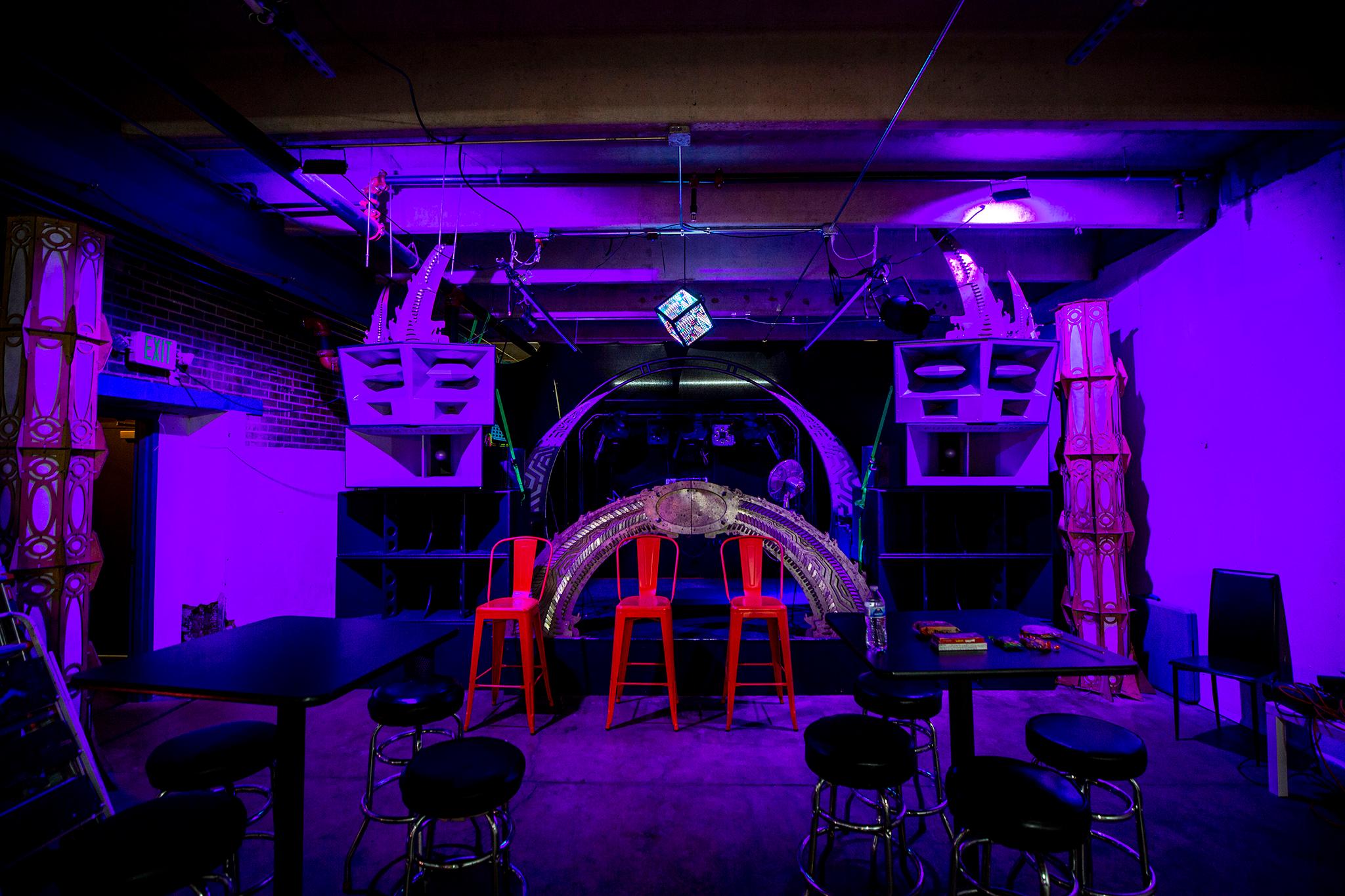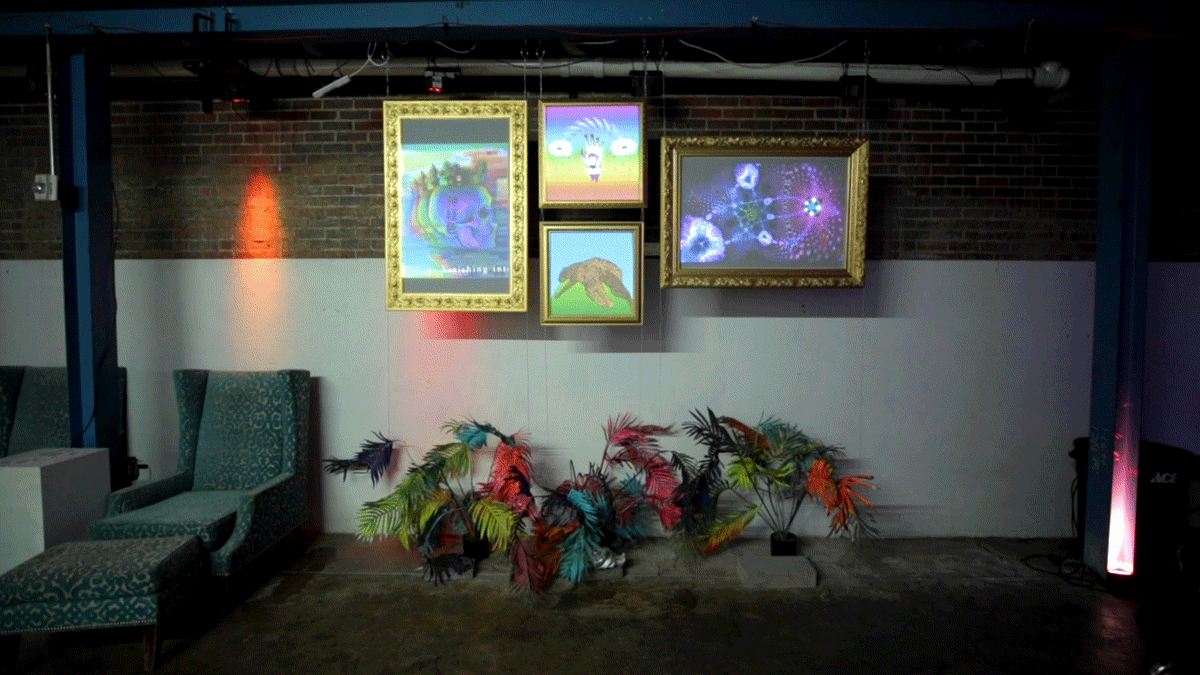Walk through a door under the Osaka Ramen sign on 26th and Walnut in Five Points, down a set of stairs and to the right, and you'll find an industrial, unfinished basement space washed in the glow of neon light and lined with "framed" digital art -- abstract "sculptures" imposed over photos of mountain landscapes, a colorful animation of George Washington sticking his tongue out and slightly raising his brows, an animatronic humanoid figure with glowing red eyes -- created to be shared and sold on digital platforms.
The space melds the tangible and intangible of Denver's art scene in a speakeasy-type setting.
The gallery is part of IRL Underground's "Viral" exhibition. The collection of physical and digital pieces are presented as artwork might be in a more traditional, familiar art space, one IRL hopes will help enfold local artists and art enthusiasts into the sometimes confusing or intimidating world of crypto art.
Since 2019, IRL Underground Gallery, a subset of IRL Art, has specialized in NFTs (non-fungible tokens) and augmented reality art. It's a members-only arts group, a physical gallery, and a "crypto speakeasy."
"Our space is underground, literally," said IRL Art founder Annie Phillips. "So it has this speakeasy vibe, like, 'If you know, you know.' Which is kind of a meme in the crypto world too."


In the last few years, NFTs, or non-fungible tokens, have blown up.
The trend is a subset of the crypto community known for buying into digital currency like Bitcoin and Ethereum.
NFTs are unique digital properties that can be bought and sold online in much the same way people would buy and sell unique and valuable assets in the real world. NFTs can be videos, memes, visual art, digitized versions of real-life murals and sculptures, and documents. Users buy and sell them online using the currency of different blockchain platforms, like Ethereum. Because the items are affiliated with a unique digital "token," their ownership is easily traced and verified.
"If you take a picture of the Mona Lisa, do you own the Mona Lisa or do you just own a crappy picture?" said local digital artist Eceertrey, who's showing some of his work in Viral. He said it's the same with NFTs. "Only one person owns the thing. And it's provable on the blockchain. And it can't be changed. It's all public."
Digital artists use this new, larger platform to monetizing their work more effectively than they might've in traditional gallery and auction spaces.
Basically: Artists create an account on an online platform like Ethereum. There, they create a digital wallet, and can "mint " NFTs, certifying their digital artwork as unique tokens. They then can auction off their artwork online and cash in on bids.

Many buyers see NFTs as investment opportunities, the way some art collectors might buy a painting with the intent of reselling it later.
"I think that a lot of real crypto maximalist people have been waiting for years. They've been investing or mining crypto, and have huge gains," Phillips said. "And so they look at these artists as the future of adoption."
Others might use NFTs in their own digital projects, project or display them in their homes, or buy them exclusively for the bragging rights.
NFTs have helped artists like Eceertrey monetize their work and reach new audiences.
Eceertrey said there's a perception that NFTs are for "NFT bros" -- for crypto zealots trying to make a ton of money to further their businesses.
"For me, it was art -- fine art, being an artist. It just opened this door. And the door's changed my life completely."
Eceertrey had worked in digital art for years. Then, in 2019, he set up an Etherium address and minted his first NFT.
"I started seeing that there were more marketplaces that were available for me to post my artwork," he said. "And it felt so much more accessible than a gallery, as someone that did digital work. It was like, 'Oh my god, they might understand what I'm actually doing!'"
He was also able to reach bidders outside of traditional art spaces, and even outside of Colorado. Now, anyone in the world can see and bid on his work at any time. And unlike gallery spaces, many platforms allow you to display work digitally without having to apply.
"The floor to entry was a lot lower than the traditional art world," he said.
NFTs can also eliminate some of the expenses presented by creating physical work. Artists don't have to print and frame NFTs. Phillips says that, on the curatorial side, working with NFTs means not having to deal with shipping art. Now, artists from all over the world can share their work to be included in IRL shows without having to deal with customs, packaging expenses and import and export fees.


NFTs are intangible. But it's that intangibility that makes them easier for artists to monetize their work.
In the traditional art world, if you sell a painting, the painting no longer belongs to you. Whatever profits you make come from that initial sale. In the NFT world, tokenization allows for easier tracing of ownership history. Artists continue to earn royalties when their works sell and resell over time. It gives artists a way to continue to benefit from the value their work might accrue over time.
"As an artist, one of the craziest things that can happen is you wake up and you're like, Oh, why did I get money today?" Eceertrey said. "And you realize that you had a secondary market sale, that some other collector bought a piece from another collector that you had sold to them, and you get 10% of a royalty from that."
The intangible nature of the platform can also help protect or preserve the artwork. A physical mural can fade over time. It can get tagged or painted over, or otherwise damaged. A mural reproduced as an NFT is impervious to that kind of damage. It can extend the life of that mural, even as it disappears from the physical world.
Because ownership is public and traceable, it's much harder for NFTs to be lost or stolen. Phillips says before NFTs, artists she worked with from outside of Colorado had to ship their works long distances, leaving them vulnerable.
"You can only get insurance for up to $1,000," she said. "So if it's anything more valuable than $1,000 it's really scary, because if it doesn't arrive or if it gets damaged, there's nothing you can really do."
"Viral" takes the digital monetization possibilities a step further. It taps into the way users interact with what they see on social media, and attempts to translate that into the art world.
"A lot of kids, they don't read poetry. They don't express themselves that way anymore. They're expressing themselves in memes, communication, and news spread digitally," Gray said. "This is what 'Viral' is about, is representing how the new age of artists and creatives and youth are really expressing themselves online."
IRL has partnered with a group called reactions.wtf to monetize "likes" and "reactions," so that the artwork can accumulate value based on how users respond to it. Participating artists will be able to upload their digital artwork to the reactions.wtf website. Users can buy "emojis" that function as tokens, and use them to "like" artworks, effectively adding their token to the piece and contributing to its value. It's a system that adds weight to the formerly intangible or transient value "likes" place on a digital work. The artist can cash in those accrued tokens, or leave the work online overtime to accrue more value.


"Viral" includes a replica exhibition that exists in a "metaverse," making it more accessible to a larger audience.
The digital version of the "Viral" gallery is a one-for-one, a virtual gallery identical to the physical one, so that anyone can see it from their smartphones, laptops or tablets.
Eceertrey explained that a metaverse is basically a digital world superimposed over our own, and one you can see when you open a given metaverse's corresponding app or program.
"There's this whole other world that's like a digital overlay over your eyes," he said. "Anything's possible in that space, you can create anything, you can visit anywhere and any time period, at any scale."
He says new augmented reality technology is moving towards allowing users to see those digital assets in the real world. For example, Eceertrey said, Snapchat's "Spectacles" glasses allow for full body tracking, so you can add the app's signature animated filters to full bodies, instead of just faces.
Eceertrey says that within some metaverses, through a process called geolocking, you can drop art anywhere in the world -- on the tops of mountains, even on government buildings -- and the people walking around the physical world wouldn't know they're there, unless they used the technology needed to access the metaverse. In these spaces, you can make art -- or graffiti -- anywhere in the world without the risk. Eceertrey said he worked with another artist to build an augmented reality sculpture outside the DAM.
"The Denver Art Museum would have never allowed me to do that," he said. But the metaverse has different rules.
Those rules depend on the application used. For example, Eceertrey owns plots of "land" that parallel real world locations through a company called Superworld. Owners of different "properties" dictate what can go there. Eceertrey himself owns a piece of a parallel Machu Picchu, and a piece of the High Line in New York.
"Those specific spots in that specific metaverse, no one else could put something in," he said. "Because on the blockchain, I own this square-by-square space. It's like digital land ownership."

Phillips says there's been some hesitancy in the local art scene to embrace NFT art.
"I think that there's still a lot of room to grow, and a lot of room for better education and more community building," she said. "I think we're still really, really early."
The crypto world can be an elusive one. IRL is working to make digital platforms more accessible to artists and patrons.
"Where we really see ourselves is in the role of education and onboarding," Phillips said. She said they've now helped more than 400 artists mint their first NFTs. And throughout "Viral's" run, IRL will host classes and panel discussions to build community and help dispel some of the confusion around NFTs.
Gray says having a physical gallery space for digital art helps make the crypto world easier to grasp for artists and collectors who are used to buying and selling art in galleries.
"It's something tangible they're able to see and are able to understand, once you actually walk into a brick-and-mortar," he said. "They normally don't understand crypto, they don't have a wallet, they don't understand what this stuff is. It's just like a jpeg to them. But once they walk into our gallery, they can understand. And we're able to actually sit down and have a conversation."
Viral will open January 1 at IRL Underground, 2611 Walnut St. in the Denver RiNo Art District. A percentage of proceeds will go to a fund for 2022 Christmas presents for the participating artists' children.













